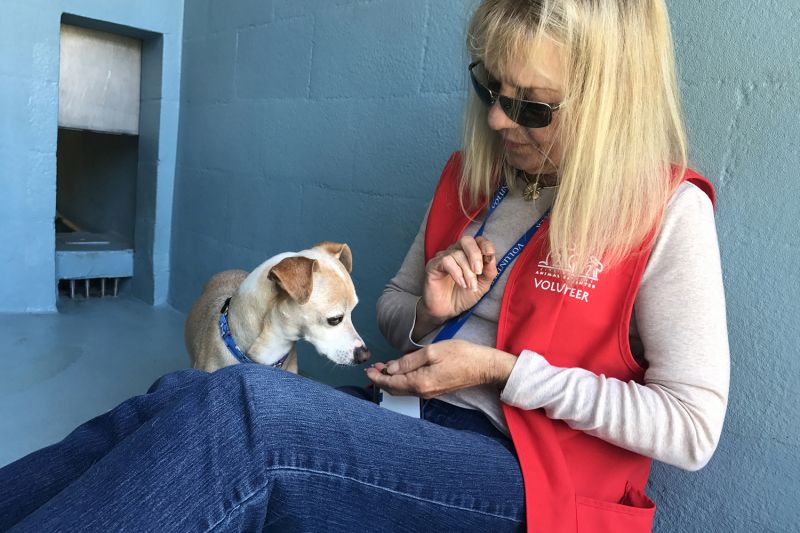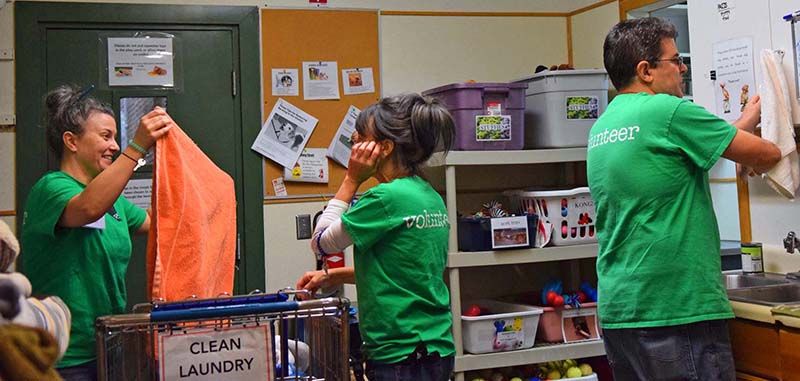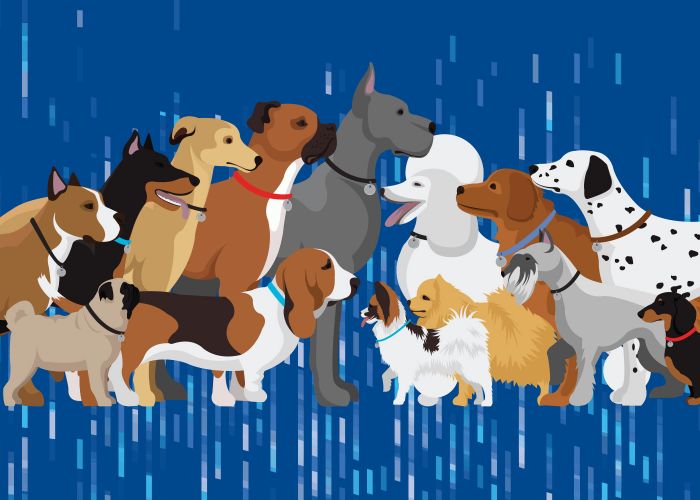Career spotlight: Volunteer managers
By leveraging the power of an unpaid workforce, volunteer managers fill an essential role in animal welfare

From high-profile shelter networks to local rescues operating on a shoestring budget, any animal welfare organization can benefit from a robust volunteer program. Whether they’re fostering neonatal kittens, answering phones, cleaning kennels, chatting with potential adopters or tabling at public events, volunteers often fill crucial gaps when paid staff are stretched thin.
“Volunteers can give staff the breathing room they need to assess their organizations’ impact, build new programs, attend conferences and focus on the bigger picture stuff they can’t get to when they’re barely getting the day to day done,” says Lindsay Hamrick, director of shelter outreach and engagement for Humane World for Animals.
A functional volunteer program that both meets an organization’s needs and provides meaningful opportunities for volunteers doesn’t “just happen,” however. Behind every well-run volunteer program is someone making that magic. Volunteer managers handle everything from recruitment to scheduling to conflict mediation, working with both staff and volunteers to make sure everyone’s needs are met. Many who hold this position started in entirely different fields before they found their way to animal welfare. Some began as volunteers themselves. Yet they’ve all discovered how this career can enrich the lives of animals and people.
“It really combined my passion for helping animals with my previous experience in HR.”
—Debbie Schockett, Humane World for Animals
Come as you are
Like many animal lovers, Tracey Rogers never thought she’d work with animals professionally because she wasn’t interested in veterinary medicine. But when the 2008 recession struck and she was laid off from her job in the construction industry, Rogers started volunteering at the Progressive Animal Welfare Society in Seattle. She quickly discovered a passion for the work and took a full-time position in shelter operations, where she did a little bit of everything: customer service, intake, adoption counseling, client services, animal care. Rogers enjoyed it all.
“I had no idea this whole world existed,” she says. In 2015, after several professional twists and turns, Rogers applied for the volunteer manager position in PAWS’ companion animal services department. “It’s been a great fit because of the time I spent in operations and the time I spent as a volunteer,” says Rogers. With her feet in both worlds, Rogers found that she could connect with staff because she’d been one of them—but she could also connect with volunteers because she’d been one of them, too.
Like Rogers, many people come to volunteer management from other careers. Debbie Schockett, program director of volunteer services for the HSUS, spent years working in human resources for a publisher, where she specialized in recruitment and employee relations. But the yearning to do something for animals led her to advocacy and volunteer work, which led her to a position at the HSUS.
“It really combined my passion for helping animals with my previous experience in HR,” says Schockett. Skills crucial to HR—staff support, training, employee relations, performance management and recruiting—all came in handy as a volunteer manager. Today, Schockett’s role is expansive: She matches volunteers to projects, collaborates with staff to create new volunteer roles, handles staffing for the Animal Care Expo and Taking Action for Animals conferences, manages the paid HSUS internship program and generally works to ensure volunteers have what they need to succeed.
Rogers too compares her job to working in human resources. “You have to have a high level of integrity,” she says. “Those kinds of skills are important—to be able to mediate and be fair and keep things private.”

Must love dogs—and people
“A lot of people fall into this job, and it’s OK if you don’t know everything,” including animal care and handling skills, says Schockett. You can pick those up on the job (providing your organization has the resources to teach you), but to succeed as a volunteer manager, you must be a people person.
Catherine Lovella, volunteer program supervisor for the Irvine Animal Care Center in California, came to volunteer management with a background in teaching and little animal welfare experience. But the soft skills and emotional intelligence necessary for managing a classroom help her manage relationships with both staff and volunteers.
“Everyone is here for the animals, but everyone is also trying to get their personal needs met, whether they know that or not,” she says. Lovella notes that emotions run high in animal welfare in a way she hasn’t experienced in other fields, so being able to calmly evaluate a stressful situation and react thoughtfully is crucial.
Experience as a teacher also served Samantha Wessel well. A former director of volunteer programs at the Humane Rescue Alliance in Washington, D.C., Wessel came to the role after realizing that the classroom setting wasn’t where she flourished. While earning a master’s degree in nonprofit management, she discovered a love for volunteer management. For her, the profession blends animal welfare with the best parts of teaching. “You can take a thing that you’re really passionate about and help other people understand why they should be really passionate about it and watch them grow on their journey just like a teacher would,” she says.
“You really have to be able to collaborate with all these departments because you’re providing a workforce for them.”
—Tracey Rogers, Progressive Animal Welfare Society
Volunteer managers must also build collaborative relationships throughout their organization. Taking the time to understand each department’s goals means you’ll be able to design volunteer roles that meet their needs. “You really have to be able to collaborate with all these departments because you’re providing a workforce for them,” says Rogers.
Although Rogers believes her customer service and retail background helped prepare her for the role, she acknowledges that it can be tough to meet everybody’s needs and that it sometimes feels like she has 300 people clamoring for her attention.
“They all need something, whether it’s ‘I need training’ or ‘I need to change my schedule’ or ‘I need to take a leave of absence.’ And then the staff are coming to you because this volunteer didn’t do what they were supposed to, or ‘they talked to me in a snarky way,’ or we don’t have enough volunteers.”
Juggling those demands can be challenging, but “it’s also what fills my cup,” she adds. “I love the animals, but I also love the people, and it’s rewarding to connect with them.”

[No] failure to communicate
Excellent written and verbal communication skills are also crucial in volunteer management, says Schockett, especially when it comes to setting expectations. That starts with creating clearly defined volunteer roles outlining what’s required of volunteers—and what’s not.
A lot of people “want to come in and work with dogs and cats, which is like code for wanting to play with puppies and kittens, or just sit with a dog on their lap,” says Lovella. But that’s not typically what’s needed as a volunteer. “Our program is highly structured, and we tell people from the beginning that your primary role is to do for the animals what they can’t do for themselves. They can’t do their own dishes; they can’t do their own laundry. The animals need enrichment, and many of them need behavior training.”
“Our program is highly structured, and we tell people from the beginning that your primary role is to do for the animals what they can’t do for themselves.”
—Catherine Lovella, Irvine Animal Care Center
Because many people might have previous volunteer experience or might have imagined the volunteer role in a very specific way, expectation-setting is crucial and helps people “decide for themselves if they’re really going to be a good match for our program,” says Lovella. She adds that it’s important for more than just volunteers: When her organization hires paid staff, they’re very explicit when a position will include working with volunteers. That way, everyone knows what to expect.
Another key part of the volunteer manager’s role is recognizing volunteers for their contributions, says Schockett. But “you want to be a good listener and thoughtful in the ways that you’re doing that, because not everyone likes to be recognized in the same way,” she adds. Schockett asks new volunteers how they want to be recognized: Will a simple, heartfelt thank-you suffice, or would someone prefer a public shout-out? Honoring your volunteers’ preferences goes a long way to fostering a trusting and positive relationship.

What you need to succeed
Depending on the size of the organization and the scope of the role, a volunteer manager’s job duties can vary—and the skills needed to succeed might vary, too. For example, Lovella handles special events for her municipal shelter, while some organizations have a separate event manager. Regardless of the scope of their jobs, volunteer managers will all benefit from certain skills.
Project management is a big one. Rogers notes similarities between her current role and her previous project management career in the construction industry. “Rolling out a volunteer role or starting a teen program or anything like that is very project-driven,” she says. “You’ve got timelines and steps to follow,” and probably a budget to meet. It’s important to be organized and focused.
Experience with data management will also help. “You’ve got a massive amount of data for all those volunteers,” says Rogers. “You’ve got all of their personal information, but also you’re keeping track of their schedules and when they worked and their hours.” Dedicated volunteer management software makes it easier, but you’ll need to be comfortable using the technology.
Understanding how to keep and interpret data can even help you better serve the community: By tracking diversity data, Wessel’s team discovered they didn’t have enough Spanish-speaking volunteers to meet their clients’ needs. Volunteers helped translate recruitment materials into Spanish, and Wessel’s team tweaked the position description to emphasize the need for bilingual volunteers. HRA eventually hired a bilingual volunteer coordinator who could work closely with Spanish-speaking volunteers.
And if all that sounds like a lot, you’re not wrong. The role can be demanding. But giving yourself permission to have creative time—where you’re not working directly on a project—can help, says Wessel. She stresses the importance of setting boundaries with staff, who might expect that the “volunteer” in your title means you’re free to help at any time.
And just like anyone in the animal welfare field, volunteer managers should take time to focus on their mental health.
“For all of the goodness, and there really is so much of it, there is also so much about working in this field that can be hard,” Lovella says. “It’s important to take good care of yourself in body and mind and spirit.”







